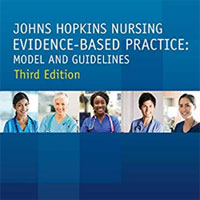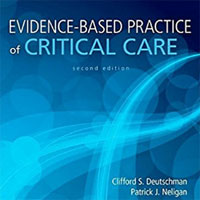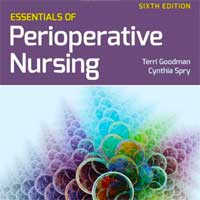Tag: guidelines
ACEP Task Force on Septic Shock Should Replace the Surviving Sepsis Campaign
The critical care community has long been plagued by a series of antiquated, overbearing guidelines created by the Surviving Sepsis Campaign (SSC). The campaign was originally sponsored by Eli Lilly and Edwards Life Sciences,... read more
Johns Hopkins Nursing Evidence-Based Practice
Johns Hopkins Nursing Evidence-Based Practice: Model and Guidelines has proven to be one of the most foundational books on EBP in nursing. This fully revised third edition builds on the strength of the first two editions... read more

Guidelines on Myocardial Infarction, Novel Therapeutic Targets in Post-infarction Remodelling
This Focus Issue on ischaemic heart disease contains the ‘2020 ESC Guidelines for the management of acute coronary syndromes in patients presenting without persistent ST-segment elevation: The Task Force for the management... read more
Effect of intubation timing on clinical outcomes of critically ill patients with COVID-19
The synthesized evidence suggests that timing of intubation may have no effect on mortality and morbidity of critically ill patients with COVID-19. These results might justify a wait-and-see approach, which may lead to fewer... read more
Timing of Intubation in Patients With COVID-19
The timing of intubation in hypoxemic patients with COVID-19 has been hotly debated. Early in the pandemic, there was a push to intubate early, driven by the effort to reduce transmission of the virus. With time, high-flow... read more
Monitoring tissue oxygenation index using near‐infrared spectroscopy during pre‐hospital resuscitation
In this pilot study, we demonstrated the feasibility of ∆TOI as a dynamic value rather than single static value among OHCA patients in a pre-hospital setting. ∆TOI can be considered as a predictor of return of spontaneous... read more
Early Mobilization of Patients Receiving Vasoactive Drugs in Critical Care Units
Evidence determining specific doses of vasoactive drugs that would allow safe mobilization of patients in critical care is lacking. The criteria that have been used to determine the eligibility to mobilize patients on vasoactive... read more
Targeting MAP in Sepsis
What’s your target mean arterial pressure (MAP) for patients with sepsis? Do you believe in the magic number of 65? What about those patients with chronic hypertension? What about when there is no evidence of end organ... read more
Barriers to reporting guideline adherence in POCUS research
Although investigators and editors recognise the importance of completely reported research, reporting quality is still a core issue for point-of-care ultrasound (POCUS) research. The shared opinion held by investigators... read more
RAPID UPDATE: Clinical Guide for the Management of Critical Care for Adults with COVID-19
This RAPID UPDATE to the FICM/ICS "Clinical guide for the management of critical care for adults with COVID-19 during the Coronavirus pandemic" highlights five clinically urgent issues for practising clinicians caring for... read more
Bacterial Superinfection Pneumonia in COVID-19 Respiratory Failure
Severe community-acquired pneumonia secondary to SARS-CoV-2 is a leading cause of death. Current guidelines recommend patients with SARS-CoV-2 pneumonia receive empirical antibiotic therapy for suspected bacterial superinfection,... read more
The Evolving Armamentarium of COVID-19 Therapeutics
Multiple repositories have been created for the vast scientific outpouring of COVID-19 research. The NIH regularly updates its treatment guidelines, which will be the primary reference for this review. To cut to the... read more
Association Between Benzodiazepine Use With or Without Opioid Use and All-Cause Mortality in the US
This study found a significant increase in all-cause mortality associated with benzodiazepine use with or without opioid use in comparison with SSRI use. Benzodiazepine and opioid co-treatment, in particular, was associated... read more
Caring for the Sickest COVID-19 Patients: An ICU Story
In an article for the latest issue of Stanford Medicine magazine, I provide a glimpse into the journey Free and his front-line Stanford Health Care colleagues took -- from Day 1 through the following weeks and months -- to... read more
CDC cuts COVID-19 Quarantine Recommendation
The CDC released new COVID-19 guidelines Dec. 2, reducing the previous 14-day quarantine recommendation for people who were exposed to 10 days without symptoms, reports CBS. The recommendation is further reduced to seven... read more
Evidence-Based Practice of Critical Care
Objective data and expert guidance on managing critically ill patients in unique question-based chapters that focus on best practices. Now thoroughly updated by Drs. Clifford S. Deutschman, Patrick J. Neligan, and nearly... read more

Ultrasound Teleguidance to Reduce Healthcare Worker Exposure to COVID-19
The recent expansion of telemedicine during the coronavirus disease 2019 (COVID-19) pandemic is likely to continue based on the Food and Drug Administration's new guidelines supporting remote monitoring technologies as a... read more
VTE and COVID-19: Would you like to know more?
Who wouldn't want to know more about a disease that has killed >1 million people to date, worldwide. Who wouldn't want to know more about the thromboembolic risk associated with COVID-19 when we have been told that the VTE... read more
Efficacy and Safety of a Paired Sedation and Ventilator Weaning
The purpose of this study is to determine the impact of a new RN/RRT (Registered Nurse/Registered Respiratory Therapist) directed 2-step protocol to wean patients off of a ventilator. This protocol involves daily attempts... read more
COVID-19: Practical Strategies to Reduce Nosocomial Transmission
The frontline healthcare workers (HCWs) are at risk for contracting the COVID-19 disease when caring for patients and providing aerosol-generating procedures. Until further high-quality studies generate robust evidence, defining... read more
Essentials of Perioperative Nursing
Essentials of Perioperative Nursing, Sixth Edition is an essential reference for new perioperative nurses as well as experienced nurses who need a refresher. Succinct and easy to use, it addresses the basics associated with... read more

NICE COVID-19 Rapid Guideline
The purpose of this guideline is to help healthcare professionals deliver efficient planned care while minimising the risk of COVID-19 in the context of increasing or decreasing local prevalence. It also aims to help patients... read more









